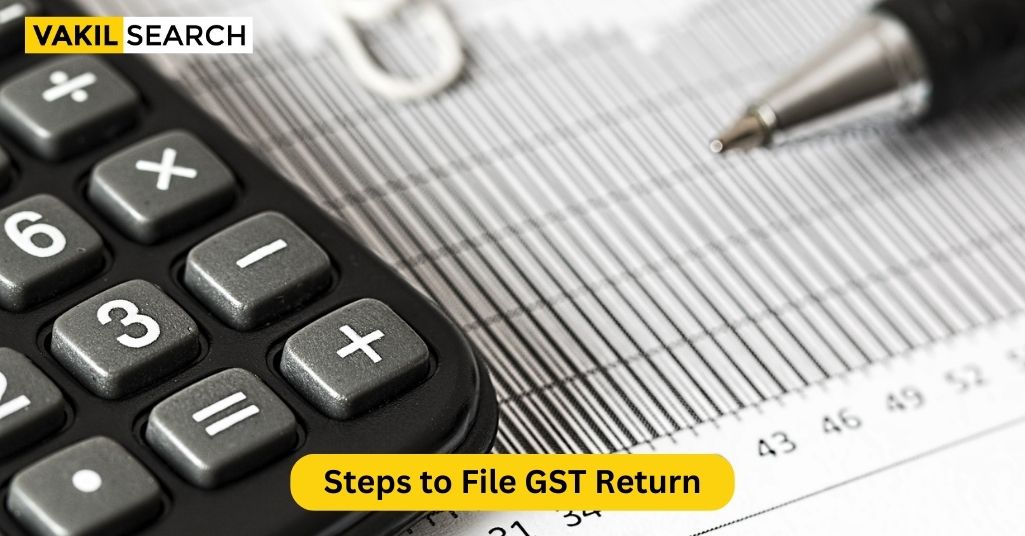The GST return can be filed online through the GST portal as set up by the GST council of the Indian government. This article walks you through the step by step process of filing GST returns.
The GST return can be filed online through the GST portal as set up by the GST council of the Indian government. Read this article ahead to know the step by steps to file Gst Return.
What is GST?
GST stands for Goods and Services Tax. An indirect tax that has largely superseded several other indirect taxes in India, including excise duty, VAT, and services tax. The Goods and Services Tax Act was enacted by Parliament on March 29, 2017, and went into effect on July 1, 2017.
To answer what GST is, in simple words, Products and Services Tax (GST) is charged on the provision of goods and services. India’s Goods and Services Tax Law is a multi-stage, destination-based tax applied on every value addition. The Goods and Services Tax (GST) is a single domestic indirect tax law that applies to the whole country.
GST Returns are a sort of form that must be filed by a taxpayer. The GST payments must be filed, after which the taxpayer must pay the tax due. The tax authorities use the information to calculate the taxpayer’s net tax due. When completing a GST return, a registered dealer must file the purchases, output GST, sales, and input tax credit.
There are around 22 different types of GST forms available. There are 11 operational GST forms, 8 view-only forms, and 3 suspended forms among the 22 GST forms. As a result, the number and kind of GST you must file are determined by the sort of taxpayer you have registered as.
Why is GST return important?
After knowing what is GST, let’s understand why it is important to file. Regardless of the type of business, sales, or profitability during the return filing period, all Registered Dealers are obliged to file GST returns. Even an inactive business that has gained GST registration is required to file the GST return under the GST Regime. Each GST Return Form is designed to guarantee full disclosure of all transactions between buyers and sellers.
Every firm, large or small, is required by law to file GST returns. These returns are submitted to pay taxes as well as to offer data to the government about the business’s transactions during the period under review. Also, it is required to keep GST status and GST check updated.
Who should file a GST return?
Any normal firm must file two monthly returns and one yearly return under the GST regime. This equates to 26 returns every year. For quarterly GSTR-1 registrants, the number of GST (check the link: https://services.gst.gov.in/services/login) filings varies. In a given year, they file 17 GST returns online. Separate GST returns must be submitted in some circumstances, such as for example, composition dealers who must file GST five times a year.
The filing procedure must be determined based on the nature of the business.
A GST return must be filed by a registered dealer who engages in the following activities:
- Sales
- Purchase
- Goods and services tax (GST) (on Sales)
- Input Tax Credit for GST paid on the purchase.
How to File GST returns?
If you’ve been wondering how to submit GST returns, don’t worry; it’s not a difficult or complicated procedure. It may be filed using the Goods and Services Tax Network (GSTN) software, which will auto-populate the forms. The following steps will walk you through the process of filing your GST return online.
Online Procedure
Step 1: Go to the GST portal.
Step 2: A 15-digit number will be assigned to you based on your state code and PAN number
Step 3: You must upload each invoice that you have. A reference number will be assigned to each invoice
Step 4: The next step is to file the external and inward returns, as well as the cumulative monthly returns. All mistakes are correctable
Step 5: On or before the 10th of the month, file the GSTR-1 outbound supply reports utilizing the information area of the GST Common Portal
Step 6: The supplier’s outbound supply will be obtained from the GSTR-2A
Step 7: Following this, the recipient must check the information of the outgoing supply and enter credit or debit note details
Step 8: Fill out the GSTR-2 form with information on the inbound supplies of goods and services
Step 9: The supplier can accept or reject the information given by the inward supply as shown on the GSTR-1A.
Offline Procedure
To file your GST returns offline, go to the following link and download the offline program, https://www.gst.gov.in/download/returns. After downloading this program, you can effortlessly fill out the GSTR-1 and GSTR-2 forms. All you have to do is follow the instructions in the link above.
How to check GST status?
Follow these instructions to verify the GST status online.
- Navigate to https://www.gst.gov.in/
- On the login screen, enter your information
- Select Service > Returns > Track Returns Status
- Select “Status of Return” from the drop-down menu
- Select the Search option
- To Be Filed / Submitted But Not Filled / Filed-Valid / Filed-Invalid are all possible statuses
- This is how you can keep track of GST return filing.
How to download the GST returns form?
In order to check GST status and GST check, here’s how to get your GST returns from the government’s website. Follow these steps in the order listed.
Step 1: Access the GST site
Step 2: Next, navigate to the Service Returns Dashboard
Step 3: Select the month and year from the drop-down menus
Step 4: Press the “Prepare Offline” button
Step 5: Go to “Download” and then click “Generate File”
Step 6: Download the link by clicking on the “Click Here” link. You should be able to download a ZIP file
Step 7: Use the GST offline tool to open this file by clicking “Open” beneath the Open Downloaded Return file from the GST portal
Now that you know how to obtain the GST return file, repeat the process for each additional GSTR file.
Conclusion
Finally, submitting GST returns used to be a time-consuming and hard task. The procedure of filling out several applications online has now made it more accessible. Once you’ve figured out which GST return forms you need to fill out, what is GST status and the GST check, the procedure may be significantly streamlined. So, file your GST returns as soon as possible!
Frequently Asked Questions
What is the process for filing a GST return step-by-step?
The process of filing a GST return in India includes the following steps:
- Gather all sales and purchase invoices.
- log in to the GST portal
- Choose the appropriate return form
- fill in the required details
- Review and correct errors
- Submit the return, and complete the process by paying
What are the essential requirements for filing a GST return in India?
Essential requirements for filing a GST return in India include a valid GSTIN, accurate financial records, detailed transaction data and reconciled accounts are crucial.
What is the filing period for GST returns, and are there different frequencies for different types of taxpayers?
The filing period for GST returns varies based on the type of taxpayer. Regular taxpayers file monthly returns, while small taxpayers can opt for quarterly returns.
Can I file my GST return directly from Tally software, and how does that process work?
Yes, you can file your GST return directly from Tally software. Tally facilitates the data entry and preparation of GST returns, streamlining the filing process.
What are the four main types of GST returns, and which businesses are required to file them?
There are four main types of GST returns: GSTR-1, GSTR-3B, GSTR-4, and GSTR-9. The business type depends on its turnover, nature of business, and registration type.
Can you explain the differences between GSTR-1 and GSTR-3B in GST return filing?
GSTR-1 is for reporting outward supplies, while GSTR-3B is a summary return that captures tax liabilities and input tax credit. GSTR-1 is filed monthly or quarterly, whereas GSTR-3B is a monthly return.
Is there a turnover threshold that determines whether a business needs to register for GST?
Yes, there is a turnover threshold that determines GST registration, businesses with an annual turnover exceeding ₹20 lakhs (₹10 lakhs for special category states) must register for GST.
How much does it cost to register for GST, and are there any applicable fees?
The cost of GST registration varies, but it's generally free. However, there may be charges for services like return filing, which can vary depending on the service provider.
Is it possible for individuals to file their own GST returns, or is a chartered accountant (CA) necessary?
While it's possible for individuals to file their own GST returns. However chartered accountants (CAs) or tax professionals can ensure accurate compliance and reduce the risk of errors.
What are the penalties or consequences if a business fails to file its GST return on time or doesn't file it at all?
Penalties for late or non-filing of GST returns include interest on outstanding tax amounts and legal consequences. Businesses could face fines and even the suspension of their GST registration. It's essential to file returns on time to avoid these penalties.










